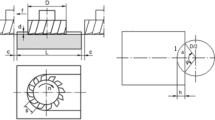Abstract
The optimization of machining parameters for machine tools using the criterion of maximum productivity rate is complex and, in many cases, an unresolved issue. The intensification of machining processes leads to changes in the productivity rate. In the case of multi-tool machining processes, engaging cutters simultaneously to define optimal machining parameters for the maximum productivity rate is an important problem. Such multi-tool processes are conducted in multi-spindle and multi-station machine tools, turret-type lathes, automated lines, etc. This paper is intended to formulate a mathematical model for the optimization of multi-tool cutting processes on machine tools based on the criterion of maximum productivity rate. The mathematical model of the new productivity rate equation (for machine tools with changes in cutting for the optimal multi-tooling operation with simultaneous action) is confirmed by practical test.
Similar content being viewed by others
References
Kalpakjian S, Schmid SR (2009) Manufacturing engineering & technology, 6th edn. Prentice Hall
Venkata Rao R (2011) Advanced modeling and optimization of manufacturing processes, 1st ed., Springer series in advanced manufacturing
Volchkevich L (2005) Automation of manufacturing processes. Mashinostroenie, Moscow
Mukherjee I, Ray PK (2006) A review of optimization techniques in metal cutting processes. Comp Ind Eng 50(1):15–34
Kountanya RK, Boppana P (2008) Optimization of machining of automotive components with polycrystalline cubic boron nitride. P I MECH ENG B-J ENG 222(7):797–805
Kumar AS, Khan MA, Thiraviam R, Sornakumar T (2006) Machining parameters optimization for alumina based ceramic cutting tools using genetic algorithms. Mach Sci Technol 10:471–489
Gupta M, Kumar S (2013) Multi-objective optimization of cutting parameters in turning using grey relational analysis. Int J Ind Eng Comput 4(4):547–558
Yang C-L (2011) Optimizing the glass fiber cutting process using the Taguchi methods and grey relational analysis. NJGC 1(1):13–19
Magdum VB, Naik VR (2013) Evaluation and optimization of machining parameter for turning of EN 8 steel. IJETT 4(5):1564–1568
Saffar RJ, Razfar MR, Salimi AH, Khani MM (2009) Optimization of machining parameters to minimize tool deflection in the end milling operation using genetic algorithm. World Appl Sci J 6(1):64–69
Lavanya KM, Suresh RK, Priya ASK, Reddy VD (2013) Optimization of process parameters in turning operation of AISI-1016 alloy steels with CBN using Taguchi method and ANOVA. IOSR-JMCE 7(2):24–27, e-ISSN: 2278–1684, p-ISSN: 2320–334X
Yazdi MRS, Khorram A (2010) Modeling and optimization of milling process by using RSM and ANN methods. IACSIT International Journal of Engineering and Technology 2(5):474–480
Ganesan H, Mohankumar G (2011) Study on optimization of machining parameters in turning process using evolutionary algorithm with experimental verification. IJMET 2(1):10–21
Deep K, Chauhan P, Pant M (2011) Optimization of machining parameters using a novel real coded genetic algorithm. Int J Appl Math Mech 7(3):53–69
Usubamatov R, Zain ZM, Ahmed AM (2011) Productivity rate of machine tools depending on the change of machining modes. P I MECH ENG B-J ENG 225(8):1447–1456
Usubamatov R, Ismail KA, Sah ZM (2013) Mathematical models for productivity and availability of automated lines. Int J Adv Manuf Technol 66(1):59–69
Author information
Authors and Affiliations
Corresponding author
Rights and permissions
About this article
Cite this article
Usubamatov, R., Zain, Z.M., Sin, T.C. et al. Optimization of multi-tool machining processes with simultaneous action. Int J Adv Manuf Technol 82, 1227–1239 (2016). https://doi.org/10.1007/s00170-015-6920-x
Received:
Accepted:
Published:
Issue Date:
DOI: https://doi.org/10.1007/s00170-015-6920-x




